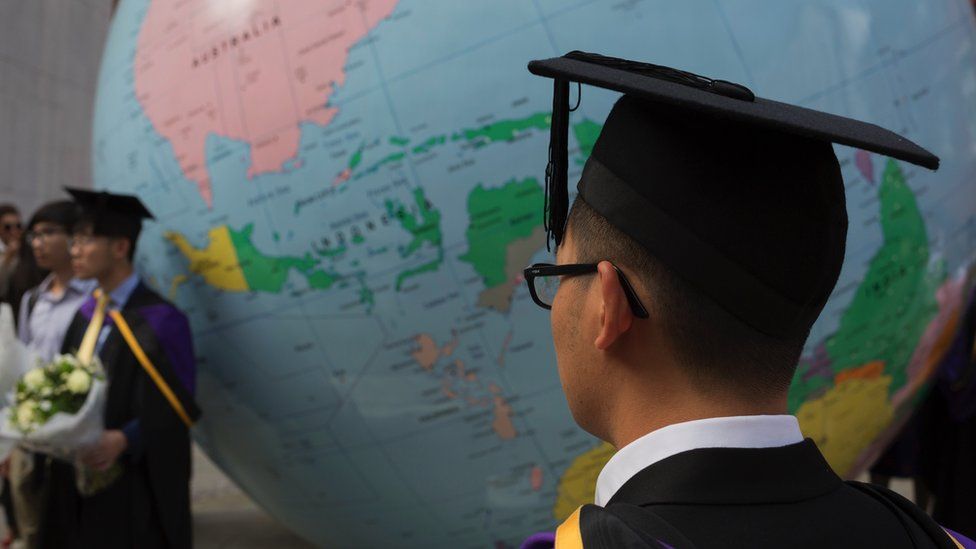
The number of international-student applications via Ucas is still higher than a decade ago
By Hazel Shearing
Education correspondent
The number of international students applying to undergraduate courses at UK universities has risen for a second year running.
New data shows 115,730 students from outside the UK applied to start in September, up from 114,910 last year.
And it follows accusations universities have lowered standards to recruit overseas students, who can be charged far more than UK students.
‘Highly unpredictable’
The number of international applicants remains below the high of 116,110 before the Covid pandemic.
Numbers fell over the next two years, when international travel was restricted, but have since been recovering.
Universities and Colleges Admissions Services (Ucas) chief executive Dr Jo Saxton said the rise in international-student applications should “not be a cause of concern for prospective domestic students”, because UK applications had also risen in recent years.
Most international students in the UK study postgraduate courses, such as master’s degrees, but they are not reflected in the new Ucas data.
‘Significant decreases’
Vivienne Stern, chief executive of Universities UK, which represents 142 higher-education institutions, told BBC Radio 4’s Today programme the data was not fully representative and universities were “worried” overall international-student numbers could still fall.
“Last year, despite applications going up, actually we saw some quite significant decreases in enrolments,” she said.
“It’s unstable and that’s seriously bad for universities because… they need international students to fund domestic education.”
Asked about the effect of any future fall in the numbers, Ms Stern said: “In the end, I think it will make it more difficult for universities to offer places to home students.”
The most a student in the UK will pay for a year of undergraduate tuition is £9,250 – the exact amount depends on where they live.
But international students can pay £38,000 per year for undergraduate courses and £30,000 per year for postgraduate courses.
In England, the tuition-fee cap has risen only once since 2012 – from £9,000 to £9,250 per year – and universities are worried it is not keeping up with inflation.
Image source, Getty Images
A report says universities are making up a £2,500 shortfall per undergraduate student
The Russell Group, which represents 24 prestigious universities, estimates a fall in the value of student loans and government teaching grants means universities are making up for a £2,500 shortfall per domestic undergraduate student.
Data from the Higher Education Statistics Agency, which represents both undergraduate and postgraduate courses, suggests the number of international-student enrolments grew from 469,160 in the 2017-18 academic year to 679,970 in 2021-22.
The increase has been driven by applications for postgraduate degrees, according to University of Oxford migration research, rather than the undergraduate courses studied by many 18-year-olds in the UK.
However, new rules this year aimed at curbing migration mean international students can no longer bring family members with them unless they are on research courses or have government-funded scholarships.
‘Political pressure’
Ms Stern said this – as well as competition from universities in countries such as the US and Australia, and UK “government rhetoric” – posed a problem for universities.
She has previously stressed universities make a loss on teaching UK students – and on research.
“Income from international students is no longer providing an additionality that allows us to invest over and above what we would be able to do with just domestic sources of income,” she told MPs last year.
“Instead of being the cherry on the cake, it is becoming the flour.”
A report from the British Council last week suggested the “post-Covid boom” in international-student numbers would end this year, because of “rising political pressure against migration” and the increasing cost of studying in the UK.
Signs of pressure on universities’ finances are already apparent, with job cuts recently announced at several universities, including the University of Aberdeen, which said it was facing serious financial challenges, and Staffordshire University, which cited a “turbulent student recruitment market at home and abroad”.
And strikes over pay and pensions have disrupted university education in recent years.
The government has a target of 600,000 international students per year studying in the UK by 2030 and says education exports “play a vital role in supporting the UK economy”.
A report last year estimated one year group of international students would bring £41.9bn in economic benefits through the course of their time in the UK.
Former universities minister Jo Johnson told the Today programme international students “bring enormous benefits to the UK” and create “huge economic value that enables universities to put on courses that wouldn’t otherwise be offered to domestic students at all”.
Attracting international students also boosts the UK’s “soft power”, through its reputation and global networking, the government says.
It surpassed its 600,000 target in 2020-21 and 2021-22, according to the most recent data.
‘Dangerously understaffed’
The figures come after accusations that universities have been lowering standards to recruit overseas students, including a Sunday Times report claimed international students were using “secret routes” to “buy their way in” to Russell Group universities.
Ms Stern said the newspaper had made a “fundamental error” by comparing foundation courses with degrees, adding: “International students are not taking home-student places and they’re not being admitted on lower grades.”
But Mr Johnson said the report “raised questions” and universities were “right to be taking it extremely seriously”, after Universities UK announced admissions processes would be reviewed to ensure the system was fair.
Meanwhile, the Ucas data also suggests the number of applicants for nursing has fallen, which the Royal College of Nursing warned could leave the NHS “dangerously understaffed”.








